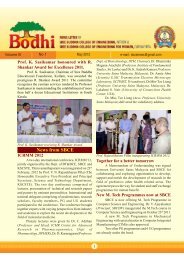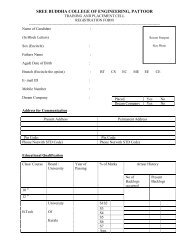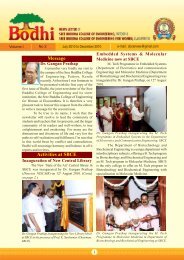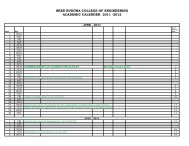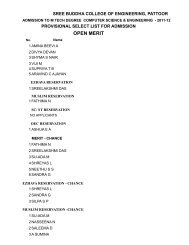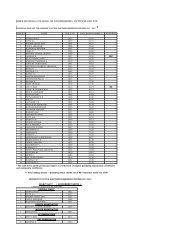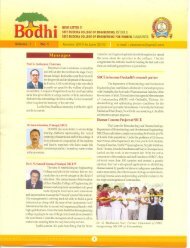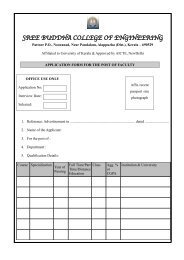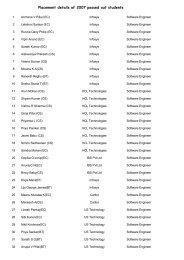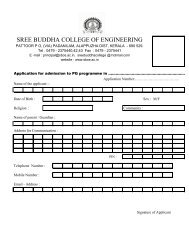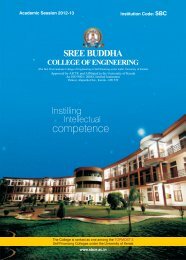UNIVERSITY OF KERALA
UNIVERSITY OF KERALA
UNIVERSITY OF KERALA
You also want an ePaper? Increase the reach of your titles
YUMPU automatically turns print PDFs into web optimized ePapers that Google loves.
vectors; Insertion and Replacement vectors; EMBL; Cosmids; Artificial chromosome vectors (YACs; BACs); Animal<br />
Virus derived vectors-SV-40; vaccinia/bacculo and retroviral vectors; Expression vectors; pMal; GST; pET-based<br />
vectors; Protein purification; His-tag; GST-tag; MBP-tag etc.; Intein-based vectors; Inclusion bodies; Methodologies to<br />
reduce formation of inclusion bodies; Baculovirus and Pichia vector system, Plant based vectors, Ti and Ri as vectors,<br />
Yeast vectors, Shuttle vectors<br />
MODULE II<br />
Cloning Methodologies: Insertion of Foreign DNA into Host Cells; Transformation; Construction of libraries;<br />
Isolation of mRNA and total RNA; cDNA and genomic libraries; cDNA and genomic cloning; Expression cloning;<br />
Jumping and hopping libraries; Southwestern and Farwestern cloning; Protein-protein interactive cloning and Yeast<br />
two hybrid system; Phage display; Principles in maximizing gene expression<br />
PCR and Its Applications: Primer design; Fidelity of thermostable enzymes; DNA polymerases; Types of PCR –<br />
multiplex, nested, reverse transcriptase, real time PCR, touchdown PCR, hot start PCR, colony PCR, cloning of PCR<br />
products; T-vectors; Proof reading enzymes; PCR in gene recombination; Deletion; addition; Overlap extension; and<br />
SOEing; Site specific mutagenesis; PCR in molecular diagnostics; Viral and bacterial detection; PCR based<br />
mutagenesis, Mutation detection: SSCP, DGGE, RFLP, Oligo Ligation Assay (OLA), MCC (Mismatch Chemical<br />
Cleavage, ASA (Allele-Specific Amplification), PTT (Protein Truncation Test)<br />
MODULE III<br />
Sequencing methods; Enzymatic DNA sequencing; Chemical sequencing of DNA; Automated DNA sequencing; RNA<br />
sequencing; Chemical Synthesis of oligonucleotides; Introduction of DNA into mammalian cells; Transfection<br />
techniques; Gene silencing techniques; Introduction to siRNA; siRNA technology; Micro RNA; Construction of siRNA<br />
vectors; Principle and application of gene silencing; Gene knockouts and Gene Therapy; Creation of knock out mice;<br />
Disease model; Somatic and germ-line therapy- in vivo and ex-vivo; Suicide gene therapy; Gene replacement; Gene<br />
targeting; Transgenics; cDNA and intragenic arrays; Differential gene expression and protein array.<br />
REFERENCES<br />
1. Primrose S.B, Twyman R.M and .Old R.W, Principles of Gene Manipulation, 6 th Edition, S.B.University<br />
Press, 2001.<br />
2. Sambrook J and Russel D.W, Molecular Cloning: A Laboratory Manual, Vol 1 Cold Spring Harbour<br />
Laboratory(CSHL), 2001.<br />
3. Brown TA, Genomes, 3rd ed. Garland Science 2006<br />
4. Desmond S.Tand Nicholl, Introduction to Genetic Engineering, Cambridge University Press, 2004<br />
7. Preeti Joshi, Genetic Engineering and its applications, Agrobios, India, 2004<br />
8. Gurbachan S.Minglani, Advanced Genetics, Narosa Publishing House, 2003<br />
9. Scott R. Hawley and Michelle Y.Walker, Advanced Genetic Analysis-Finding meaning in a Genome,<br />
Blackwell Publishing Company, 2004.<br />
The question paper consists of Part A and Part B. Part A is for 40 marks. Part A consists of 10 compulsory short<br />
answer questions each carrying 4 marks covering the entire syllabus.<br />
Part B is for 60 marks. There will be two questions from each module. The candidate has to answer one question of 20<br />
marks from each module.<br />
No charts, tables, codes are permitted in the Examination hall if necessary relevant data is given along with the<br />
question paper by the question paper setter.<br />
08.503 ENZYME ENGINEERING AND TECHNOLOGY (B)<br />
Credits: 03 L/T/P: 2/1/0<br />
MODULE I<br />
Introduction: Enzymes as biocatalysts- Chemical nature of enzymes- role of coenzymes – comparison of enzymes<br />
with chemical catalysts- nomenclature and classification- Oxidoreductases, Transferases, Hydrolases, Lyases,<br />
Isomerases, Ligases- specificity of enzyme action- types of substrate specificity- theories of Enzyme substrate complex<br />
formation- Fischer’s template theory, Koshland’s theory, Substrate strain theory -action of enzymes- proximity effect<br />
and orbital steering- mechanism of enzyme catalysis- theories of reaction rates- collision theory, transition state theory.<br />
Extremozymes- non traditional enzymes- Abzymes, Ribozymes.<br />
36



